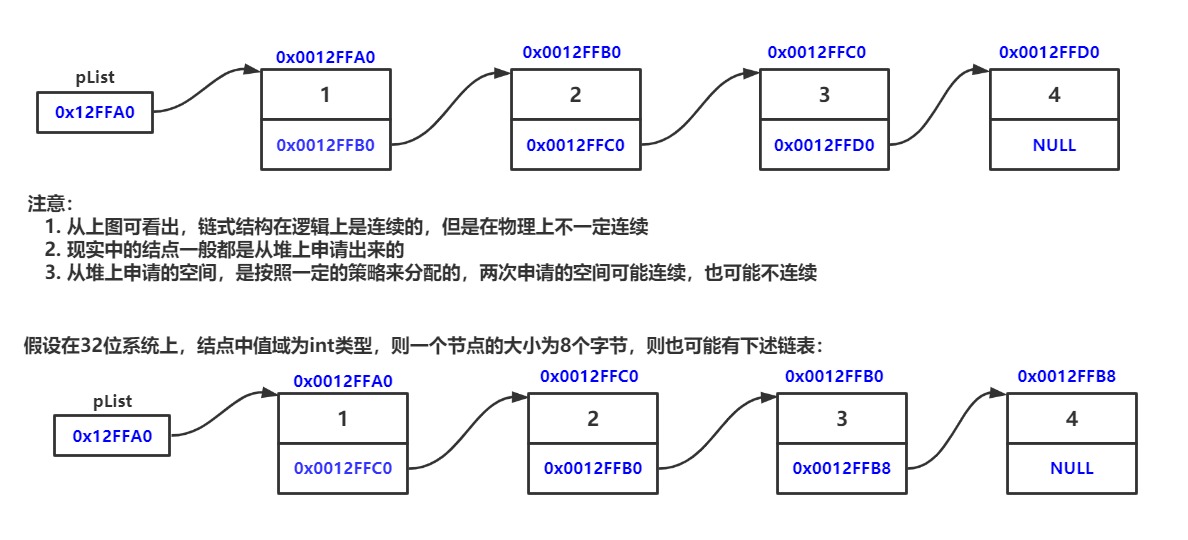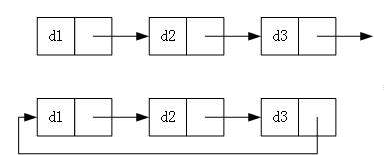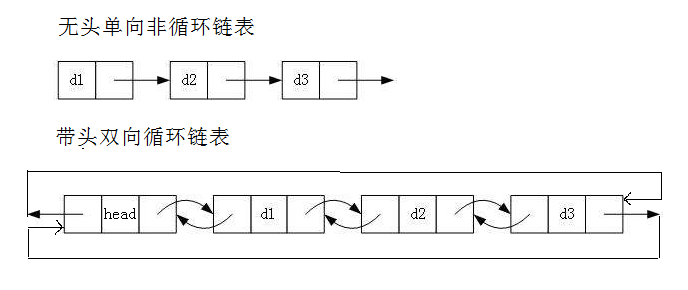【数据结构】链表简介及单链表的实现
发布时间:2024年01月05日
简单不先于复杂,而是在复杂之后。
1. 链表
1.1 链表的概念及结构
概念:链表是一种物理存储结构上非连续,非顺序的存储结构,数据元素的逻辑顺序是通过链表中的指针链接次序实现的。
现实中 数据结构中
1.2 链表的分类
实际中链表的结构非常多样,以下情况组合起来就有 8 种链表结构:
- 单向或双向:
- 带头或不带头:
- 循环或非循环:
虽然有这么多的链表的结构,但是我们实际中最常用的还是这两种结构:
- 无头单项非循环链表:结构简单,一般不会单独用来存数据。实际中更多是作为其他数据结构的子结构,如哈希桶、图的邻接表等等。另外这种结构在笔试面试中出现很多。
- 带头双向循环链表:结构最复杂,一般用在单独存储数据。实际中使用的链表数据结构,都是带头双向循环链表。另外这个结构虽然结构复杂,但是使用代码实现以后会发现结构会带来很多优势,实现反而简单。
1.3 无头单向非循环链表的实现
Slist.h
#pragma once
#include<stdio.h>
#include<assert.h>
#include<stdlib.h>
typedef int SLTDataType;
typedef struct SlistNode
{
SLTDataType data;
struct SListNode* next;
}SLTNode,*PSLTNode;
//以下三种形式等价
//SLTNode*
//PSLTNode
//struct SlistNode
//动态申请一个结点
SLTNode* BuySLTNode(SLTDataType x);
//打印链表
void SListPrint(SLTNode* phead);
//void SListPrint(PSLTNode phead);
//销毁链表
//不及时销毁链表是一种内存泄露
void SListDestory(SLTNode** pphead);
//头插
void SListPushFront(SLTNode** pphead, SLTDataType x);
//尾插
void SListPushBack(SLTNode** pphead, SLTDataType x);
//尾删
void SListPopBack(SLTNode** pphead);
//头删
void SListPopFront(SLTNode** pphead);
//查找
//可以充当修改
SLTNode* SlistFind(SLTNode* phead, SLTDataType x);
//在pos之前插入
void SlistInsert(SLTNode** pphead, SLTNode* pos, SLTDataType x);
//在pos之后插入
void SlistInsertAfter(SLTNode* pos, SLTDataType x);
//删除pos位置
void SlistErase(SLTNode** pphead, SLTNode* pos);
//删除pos后面位置
void SlistEraseAfter(SLTNode* pos, SLTDataType x);
Slist.c
#define _CRT_SECURE_NO_WARNINGS 1
#include"Slist.h"
void SListPrint(SLTNode* phead)
{
//不能断言,因为phead为空是正常情况,表示空链表
SLTNode* cur = phead;
while (cur != NULL)
{
printf("%d->", cur->data);
cur = cur->next;
}
printf("NULL\n");
}
SLTNode* BuySLTNode(SLTDataType x)
{
SLTNode* newnode = (SLTNode*)malloc(sizeof(SLTNode));
if (newnode == NULL)
{
perror("malloc fail");
exit(-1);
}
newnode->data = x;
newnode->next = NULL;
return newnode;
}
void SListPushFront(SLTNode** pphead, SLTDataType x)
{
assert(pphead);
SLTNode* newnode = BuySLTNode(x);
newnode->next = *pphead;
*pphead = newnode;
}
void SListPushBack(SLTNode** pphead, SLTDataType x)
{
assert(pphead);
SLTNode* newnode = BuySLTNode(x);
//1. 链表为空
//2. 链表非空
if (*pphead == NULL)
{
*pphead = newnode;
}
else
{
//找尾
SLTNode* tail = *pphead;
while (tail->next != NULL)
{
tail = tail->next;
}
tail->next = newnode;
//尾插改变的是结构体成员,所以不用二级指针(结构体指针的指针),用结构体指针
}
}
void SListPopBack(SLTNode** pphead)
{
assert(pphead);
//1.多个节点
//2.一个节点
if (*pphead == NULL)
{
return;
}
if ((*pphead)->next == NULL)
{
free(*pphead);
*pphead = NULL;
}
else
{
SLTNode* prev = NULL;
SLTNode* tail = *pphead;
while (tail->next != NULL)
{
prev = tail;
tail = tail->next;
}
prev->next = NULL;
free(tail);
tail = NULL;
}
}
void SListPopFront(SLTNode** pphead)
{
assert(pphead);
//温柔的检查
if (*pphead == NULL)
{
return;
}
暴力检查
//assert(*pphead != NULL);
SLTNode* del = *pphead;
*pphead = (*pphead)->next;
free(del);
del = NULL;
}
void SListDestory(SLTNode** pphead)
{
assert(pphead);
SLTNode* cur = *pphead;
while (cur)
{
SLTNode* next = cur->next;
free(cur);
cur = next;
}
*pphead = NULL;
}
SLTNode* SlistFind(SLTNode* phead, SLTDataType x)
{
SLTNode* cur = phead;
while (cur)
{
if (cur->data == x)
{
return cur;
}
cur = cur->next;
}
return NULL;
}
void SlistInsert(SLTNode** pphead, SLTNode* pos, SLTDataType x)
{
assert(pphead);
assert(pos);
if (pos == *pphead)
{
SListPushFront(pphead, x);
}
else
{
SLTNode* prev = *pphead;
while (prev->next != pos)
{
prev = prev->next;
//暴力检查,pos不在链表中,prev为空还没有找到pos说明pos传错了
assert(prev);
}
SLTNode* newnode = BuySLTNode(x);
prev->next = newnode;
newnode->next = pos;
}
}
void SlistInsertAfter(SLTNode* pos, SLTDataType x)
{
assert(pos);
SLTNode* newnode = BuySLTNode(x);
newnode->next = pos->next;
pos->next = newnode;
}
void SlistErase(SLTNode** pphead, SLTNode* pos)
{
assert(pphead);
assert(pos);
if (*pphead == pos)
{
SListPopFront(pphead);
}
else
{
SLTNode* prev = *pphead;
while (prev->next != pos)
{
prev = prev->next;
//检查pos不是链表中节点,参数传错了
assert(prev);
}
prev->next = pos->next;
free(pos);
}
}
void SlistInsertAfter(SLTNode* pos, SLTDataType x)
{
assert(pos);
if (pos->next == NULL)
{
return;
}
else
{
SLTNode* next = pos->next;
pos->next = next->next;
free(next);
}
}
test.c
#define _CRT_SECURE_NO_WARNINGS 1
#include"Slist.h"
void TestSlist1()
{
SLTNode* plist = NULL;
SListPushFront(&plist, 1);
SListPushFront(&plist, 2);
SListPushFront(&plist, 3);
SListPushFront(&plist, 4);
SListPrint(plist);
}
void TestSlist2()
{
SLTNode* plist = NULL;
SListPushBack(&plist, 1);
SListPushBack(&plist, 2);
SListPushBack(&plist, 3);
SListPushBack(&plist, 4);
SListPrint(plist);
//SListPopBack(&plist);
//SListPopBack(&plist);
//SListPopBack(&plist);
//SListPopBack(&plist);
//SListPopBack(&plist);
//SListDestory(&plist);
SLTNode* pos = SlistFind(plist, 3);
if (pos)
{
//修改
//SlistInsert(&plist, pos, 20);
SlistErase(&plist, pos);
printf("找到了\n");
}
else
{
printf("没找到\n");
}
SListPrint(plist);
}
int main()
{
//TestSlist1();
TestSlist2();
return 0;
}
单链表只适合头插头删,时间复杂度 O(1)
(next);
}
}
`test.c`
```c
#define _CRT_SECURE_NO_WARNINGS 1
#include"Slist.h"
void TestSlist1()
{
SLTNode* plist = NULL;
SListPushFront(&plist, 1);
SListPushFront(&plist, 2);
SListPushFront(&plist, 3);
SListPushFront(&plist, 4);
SListPrint(plist);
}
void TestSlist2()
{
SLTNode* plist = NULL;
SListPushBack(&plist, 1);
SListPushBack(&plist, 2);
SListPushBack(&plist, 3);
SListPushBack(&plist, 4);
SListPrint(plist);
//SListPopBack(&plist);
//SListPopBack(&plist);
//SListPopBack(&plist);
//SListPopBack(&plist);
//SListPopBack(&plist);
//SListDestory(&plist);
SLTNode* pos = SlistFind(plist, 3);
if (pos)
{
//修改
//SlistInsert(&plist, pos, 20);
SlistErase(&plist, pos);
printf("找到了\n");
}
else
{
printf("没找到\n");
}
SListPrint(plist);
}
int main()
{
//TestSlist1();
TestSlist2();
return 0;
}
单链表只适合头插头删,时间复杂度 O(1)
任意位置高效插入删除要交给之后文章讲解的双向链表。
文章来源:https://blog.csdn.net/Lixinze__/article/details/135370223
本文来自互联网用户投稿,该文观点仅代表作者本人,不代表本站立场。本站仅提供信息存储空间服务,不拥有所有权,不承担相关法律责任。 如若内容造成侵权/违法违规/事实不符,请联系我的编程经验分享网邮箱:chenni525@qq.com进行投诉反馈,一经查实,立即删除!
本文来自互联网用户投稿,该文观点仅代表作者本人,不代表本站立场。本站仅提供信息存储空间服务,不拥有所有权,不承担相关法律责任。 如若内容造成侵权/违法违规/事实不符,请联系我的编程经验分享网邮箱:chenni525@qq.com进行投诉反馈,一经查实,立即删除!
最新文章







